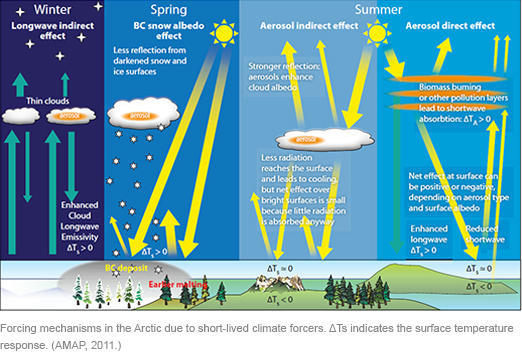It has lately been estimated that black carbon is the second most important pollutant forcing the climate change. Only carbon dioxide emissions are estimated to have a greater effect on climate. (e.g., Jacobson 2001; Bond et al, 2013). Aerosols containing black carbon, organic carbon and sulfates as well as methane (CH4) and ozone (O3) are commonly identified as short-lived climate forcers (SLCF) or short-lived climate pollutants (SLCP). Aerosols remain in the atmosphere only from days to few weeks.
The climate forcing mechanisms of the SLCFs are depicted in the figure below. Black carbon particles absorb visible light efficiently. As a result, they heat the amosphere in contrast to purely scattering aerosol such as sulfate or sea-salt particles that cool the atmosphere by scattering solar radiation back to space. The indirect effects of black carbon particles are caused by their influence on the properties and processes of clouds and snow surfaces.
Climate forcing mechanisms of black carbon
Direct radiative forcing of black carbon is caused by absorption and scattering of sunlight. Absorption of sunlight by black carbon heats the atmosphere and reduces sunlight that reaches the surface and that is reflected back to space. When black carbon is above a highly reflective surface, such as clouds or snow, it also absorbs solar radiation reflected from the surface. The consequence is that above snow-covered polar regions a clearly smaller amount of black carbon leads to atmospheric heating than above darker surfaces, for instance forests, grass fields, or open sea.
The added atmospheric heating will subsequently increase the downward longwave radiation to the surface, warming the surface (e.g., Quinn et al, 2011). Heating within the atmosphere and a reduction in sunlight reaching the surface may also change the hydrological cycle through changes in latent heating, vertical temperature profile and thus convective heat transfer and even large-scale circulation patterns (Ramanathan and Carmichael, 2008,).
 Photo: Transport of smoke from forest fires in Eastern Siberia. Flickr, NASA Goddard Space Center.
Photo: Transport of smoke from forest fires in Eastern Siberia. Flickr, NASA Goddard Space Center.
Black carbon and clouds
Black carbon influences the properties of clouds through various complex processes (Bond et al., 2013), for instance by:
- changing the number of liquid cloud droplets,
- enhancing precipitation in mixed-phase clouds, and
- changing ice particle number and cloud extent.
The resulting radiative changes in the atmosphere are considered indirect climate effects of black carbon. In addition, in the semi-direct effect, light absorption by black carbon alters the atmospheric temperature structure within, below, or above clouds and consequently alters cloud distributions (e.g., Koch et al., 2010).
Liquid-cloud and semi-direct effects may either warm or cool the climate. Light absorption by black carbon within cloud droplets and mixed-phase cloud changes cause climate warming. For ice clouds the processes are less known so even the sign of black carbon ice-cloud forcing is unknown.
Black carbon on snow
 Photo: Aki Virkkula
Photo: Aki Virkkula
Once deposited on snow, black carbon particles absorb solar radiation and decrease the albedo of snow, i.e., how well the snow reflects sunlight. This results in heating the snow and accelerating its melting. This is significant since snow spatial coverage is tightly coupled to climate through snow albedo feedback. This process has been studied for decades (e.g., Warren and Wiscombe, 1980) and it is recognized as one of the most important climate forcers in the polar areas (e.g., Flanner et al., 2007; Quinn et al., 2008).
It has been estimated that effect on snow albedo may be responsible for as much as a quarter of the observed global warming. However, there is still a need for more complete measurements of black carbon in Arctic snow and better quantification of the links to snow albedo, melting ice, and climate change (Hansen and Nazarenko, 2004).





 Photo: Transport of smoke from forest fires in Eastern Siberia. Flickr, NASA Goddard Space Center.
Photo: Transport of smoke from forest fires in Eastern Siberia. Flickr, NASA Goddard Space Center.
 Photo: Aki Virkkula
Photo: Aki Virkkula